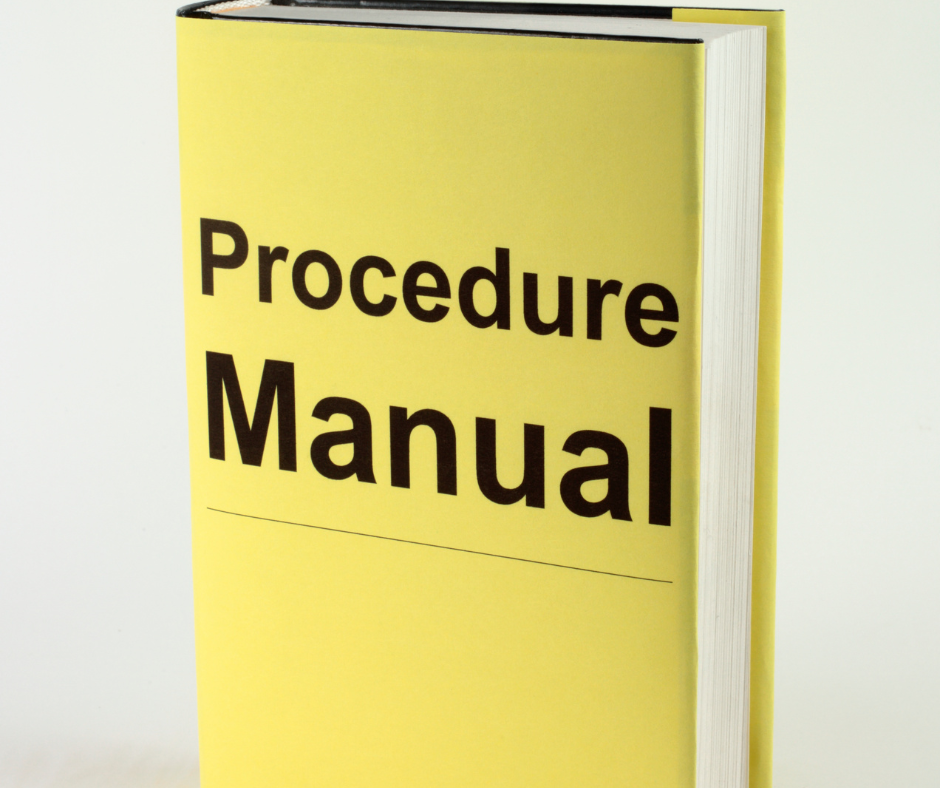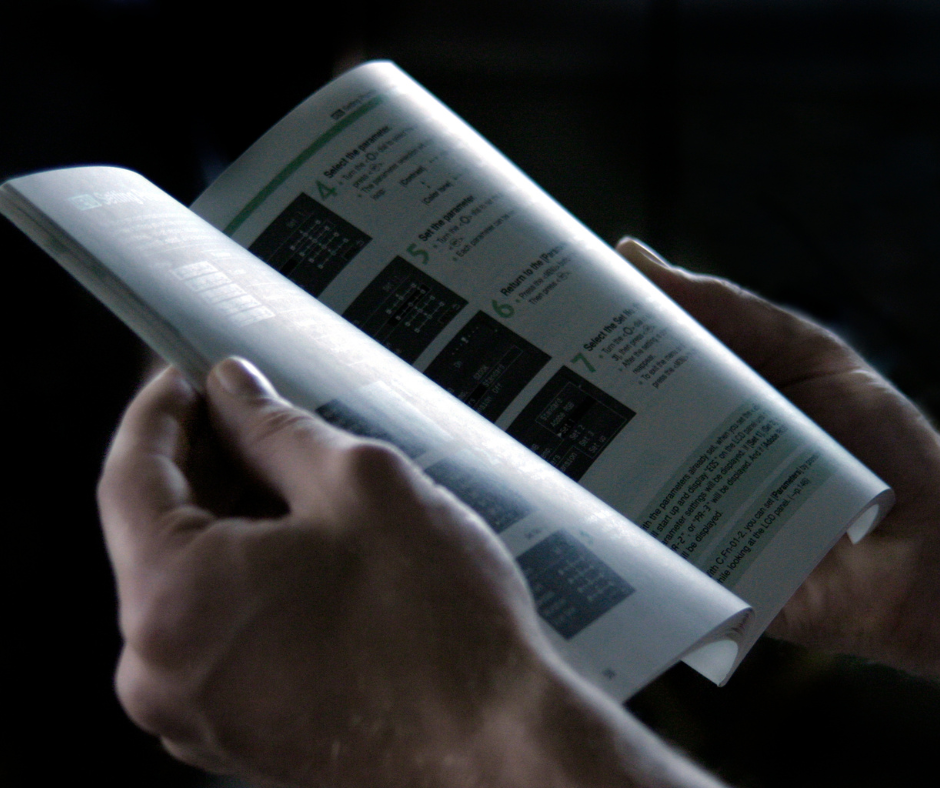
In the fast-paced world of business, ensuring that employees understand and follow established procedures is critical to achieving operational efficiency. A well-developed procedure manual is a powerful tool for streamlining processes, enhancing communication, and minimizing errors. So, what makes an effective procedure manual, and how can you create one for your organization? To get started, consider reviewing procedure manual examples. Read on to find out more.
Key Takeaways
- A procedure manual is a document designed to facilitate efficient and effective communication within an organization by outlining step-by-step processes.
- Procedure manuals are essential in fostering consistency, improving productivity, and adhering to legal regulations.
- This article provides an overview of key components for creating successful procedure manuals as well as best practices for implementation.
Understanding Procedure Manuals: Definition and Purpose
A procedure manual is a document that outlines the step-by-step processes and guidelines for employees to follow in their daily tasks, promoting efficiency, effectiveness, and communication within an organization’s basic business operations. These manuals establish guidelines and protocols, ensuring that employees understand their roles and responsibilities, and have a clear understanding of required actions for specific tasks.
Crafting a procedure manual aligns all employees and ensures everyone is working towards the same goals.

What is a Procedure Manual?
From onboarding new employees to maintaining legal requirements, a well-developed procedure manual is a valuable resource. It serves as a single point of reference, consolidating the company’s mission, values, and prospects, and providing comprehensive instructions for relevant policies and procedures, including hiring procedures. A policy and procedure manual ensures that all employees have access to the same information, leading to a more consistent and efficient workplace.
A procedure manual may cover various aspects of an organization’s operations, such as office procedures, safety procedures, and job descriptions, ensuring a safe work environment for all employees by following standard operating procedures.
Importance of Procedure Manuals
Policy and procedure manuals serve as a cornerstone for preserving consistency, enhancing productivity, and complying with laws and regulations. They play a crucial role in employee onboarding and training, ensuring that all new hires receive the same training across the same topics and responsibilities. To maintain this level of consistency, it is essential to create procedure manuals that are clear, concise, and easy to follow.
Additionally, adhering to the regulations set out in a comprehensive procedure manual can help hold individuals accountable for their actions, ultimately reducing the potential for human error.
Example of Manual
An example of a manual can be found in the user guide for a popular smartphone, detailing step-by-step instructions on how to set up and operate the device. This example of a manual typically includes information about initial setup, key features, troubleshooting tips, and frequently asked questions. The manual offers a structured approach to help users navigate the complexities of the smartphone, providing a comprehensive reference to maximize its functionality. Users often rely on this example of a manual to familiarize themselves with the device’s capabilities and to troubleshoot any issues they may encounter during usage. Clear and concise language is employed in this manual to ensure users can easily comprehend and follow the instructions.
Procedure Manual Examples: Key Components and Best Practices

Analyzing successful procedure manual examples provides valuable insights into key components and best practices for manual creation. These components include:
- Organization culture
- Employment procedures
- Employee benefits
- Work-from-home policies
- Communication policies
Some of the most effective practices for creating procedure manuals include:
- Identifying the tasks that require detailed procedures
- Establishing a list of priorities
- Collecting relevant information
- Establishing a logical order
- Utilizing clear and consistent formatting when writing
We will delve into the different types of procedure manuals, their integral components, along with the best methodologies for their creation.
Types of Procedure Manuals
There are various types of procedure manuals, such as:
- General procedure manuals
- Task-specific procedure manuals
- Departmental procedure manuals
- Compliance procedure manuals
- Safety procedure manuals
- HR procedure manuals
- IT procedure manuals
- Customer service procedure manuals
Each type serves a specific purpose and caters to different aspects of an organization’s basic business operations.
An HR procedure manual, for example, outlines the policies, procedures, and guidelines pertaining to human resources within an organization, providing employees with information on how to address various HR-related tasks and situations. This manual ensures uniformity and impartiality in the organization’s employee-related practices, ultimately contributing to a more efficient and harmonious work environment.
Key Components of Procedure Manuals
A procedure manual should contain vital elements such as:
- Clear titles
- Introductions
- The purpose of policies
- Scope
- Responsibilities
- Detailed instructions
- References
These components help ensure that the manual is easily accessible and comprehensible to all employees, providing them with the necessary information to carry out their tasks effectively.
A well-organized procedure manual should include the following sections:
- Comprehensive outline and guidelines
- Policies and procedures
- Training materials
- Performance management
- Feedback and improvement
- Employee handbooks
- Documentation
This structured approach ensures that the manual serves as an authoritative resource for employees, enabling them to follow established procedures and contribute to the organization’s success.
Best Practices for Creating Procedure Manuals
In crafting an impactful procedure manual, giving priority to mandated policies, such as those stipulated by federal or state laws, is of utmost importance. Additionally, using clear and precise language when writing the manual ensures that employees understand the procedures and can follow them accurately, ultimately reducing errors and increasing efficiency.
Another important best practice is to update the content of the procedure manual regularly, ensuring that the information is accurate, up-to-date, and relevant. Regular updates demonstrate that the organization is responsive to feedback and committed to providing the most current information to its users.
Business Manual: A Comprehensive Guide for Organizational Success
A well-structured and accessible business manual is an indispensable tool for ensuring organizational success and smooth operations within any company. A business manual serves as a comprehensive guide that outlines essential policies, procedures, and guidelines necessary for employees to understand their roles and responsibilities effectively. Within this document, the term “business manual” refers to a meticulously crafted repository of best practices, protocols, and standard operating procedures tailored to a specific organization’s needs. It encapsulates vital information concerning various facets of the business, such as human resources, financial management, operational protocols, and compliance measures. This manual acts as a reference point, fostering consistency and coherence across the organization, ultimately promoting efficiency, accountability, and a unified approach towards achieving common objectives. Additionally, it serves as an invaluable training tool for onboarding new employees, ensuring a seamless integration into the company’s culture and practices.
Step-by-Step Guide to Creating Your Own Procedure Manual

The following steps will guide you in creating your own procedure manual:
- Conducting research
- Team assembly
- Drafting and organizing content
- Reviewing, revising, and validating
- Obtaining approval
- Distributing the manual
Adhering to this step-by-step guide will aid in creating an effective procedure manual, proving to be a comprehensive, well-structured, and valuable resource for employees, fostering organizational success.
Conduct Research
Begin by conducting research and consulting with various departments to identify the specific needs and requirements of your organization. This will help you understand the overall scope of the manual and ensure that it covers all the necessary information.
Also, be sure to familiarize yourself with any relevant laws and regulations that your organization must adhere to.
Assemble a Team
Assembling a diverse team with representatives from every department is crucial for creating a comprehensive and well-reviewed manual. These team members should possess skills such as:
- Writing
- Organization
- Communication
- Research
- Technical expertise
- Collaboration
- Problem-solving
By involving a diverse range of expertise, you can ensure that the manual addresses the needs of all your employees and remains relevant and useful.
Draft and Organize Content
Draft and organize the content of your manual using a blueprint style layout. This includes:
- Title block
- Subcategories
- Sections
- Explicit instructions
- Visual aids
- Table of contents
- Index
This layout will help ensure that the manual is organized logically and is easily accessible to all employees.
Review, Revise, and Validate
Once the draft of your procedure manual is completed, gather feedback from stakeholders, subject matter experts, and employees. This feedback will help you identify any discrepancies, inaccuracies, or areas for improvement.
Be sure to update and revise your manual as needed, and validate the information to ensure that it is accurate and up-to-date.
Obtain Approval and Distribute
After revising your manual, obtain final approval from executive team members and distribute the manual to employees through various channels.
Securing the review and approval of key decision-makers for the manual ensures its credibility as a reliable resource for your organization.
Using Templates for Procedure Manuals

Utilizing templates for procedure manuals can save time and ensure consistency across your organization. Templates offer standardized formatting, making it easier to create and customize procedure manuals for various departments.
In the subsequent sections, we will explore the benefits of using templates and offer a free procedure manual template for download, which can serve as a starting point.
Advantages of Using Templates
Using templates for procedure manuals offers a number of advantages, including standardized formatting, time savings, and ease of customization. Standardized formatting ensures that all manuals have a consistent look and feel, making them more user-friendly and easier to navigate.
Additionally, templates save time by providing a pre-made structure that can be easily customized to suit your organization’s specific needs.
Free Downloadable Procedure Manual Template
To kick-start the creation of your own procedure manual, we’re offering a customizable, free downloadable template tailored to your organization’s needs. This template includes all the necessary information and sections to create a comprehensive and well-organized manual, ensuring that your employees have access to clear and concise instructions for performing their tasks.
This user-friendly template is adaptable to suit the unique needs of any organization.
Templates for Training Manuals
When creating training manuals, utilizing templates for training manuals can significantly streamline the process and enhance overall efficiency. These templates are pre-designed structures that provide a framework for organizing training materials in a clear and cohesive manner. They typically include sections for objectives, content, exercises, assessments, and other essential components necessary for effective training. By utilizing templates for training manuals, trainers can ensure consistency in formatting, language, and presentation style, which contributes to a professional and polished final product. Moreover, templates can serve as valuable guidelines, enabling trainers to focus more on customizing content to meet specific training objectives and target audience needs, ultimately improving the overall training experience.
Case Studies: Successful Procedure Manual Examples

For a better understanding of the advantages of well-structured procedure manuals, we will examine two case studies from diverse industries demonstrating successful manual implementation. These case studies demonstrate how organizations can streamline their operations, improve employee productivity, and ensure compliance with safety regulations through the implementation of effective procedure manuals.
For example, a manufacturing company was able to reduce its production costs by 20% after implementing
Case Study 1: Tech Company
In our first case study, a tech company implemented a well-organized procedure manual to streamline its operations and improve employee productivity. Through the implementation of standardized processes and clear guidelines, the company was able to minimize errors and save time by eliminating the need for employees to figure out how to complete tasks independently.
As a result, the company saw significant improvements in efficiency and productivity.
Case Study 2: Manufacturing Firm
In the second case study, a manufacturing firm tackled challenges such as ineffective manual stock checks, strict industry regulations, and product inconsistencies by creating a comprehensive procedure manual. This manual helped standardize processes, improve efficiency, and ensure compliance with safety regulations.
As a result, the firm was able to achieve the following benefits:
- Significantly reduce training time
- Enable new employees to quickly acquire and comprehend the manufacturing processes
- Ensure the consistent quality of their products
Summary
In conclusion, well-developed procedure manuals play a crucial role in streamlining processes, enhancing communication, and minimizing errors within an organization. By understanding the key components and best practices for creating effective procedure manuals, you can develop a valuable resource that will contribute to your organization’s success. Whether you create your manual from scratch or utilize a template as a starting point, the key is to ensure that your manual is comprehensive, well-organized, and easily accessible to all employees.
Frequently Asked Questions
How do you write a procedure manual?
To write a procedure manual, begin by determining which tasks need detailed procedures and creating a list of priorities. Then, gather information and create a logical order before writing the initial draft. Finally, send the draft out for review and validate the procedures.
What is a procedure manual?
A procedure manual is a comprehensive resource for employees, outlining action-oriented procedures to improve the effectiveness, efficiency and communication of business processes.
What contents are in a procedure manual?
A procedure manual outlines all the important information team members need to understand and follow a procedure, such as organization culture, employment procedures, employee benefits, work-from-home policies, communication policies, workplace guidelines, payment procedures, and employee code of conduct.
What is the purpose of a procedure manual?
A procedure manual provides employees with step-by-step processes and guidelines for daily tasks, helping to ensure efficiency, effectiveness, and communication within an organization’s business operations.
What types of procedure manuals are there?
There are various types of procedure manuals, including general, task-specific, departmental, compliance, safety, HR, IT, and customer service.